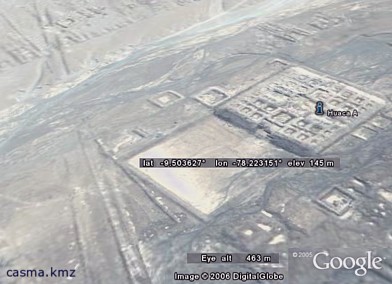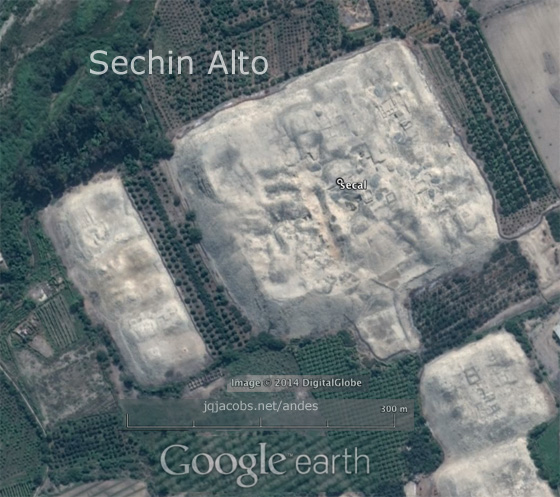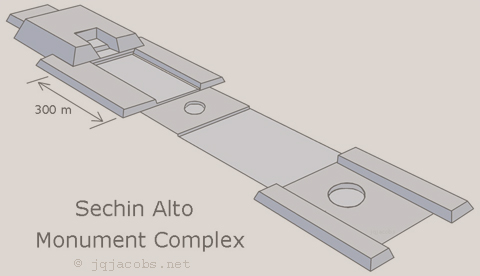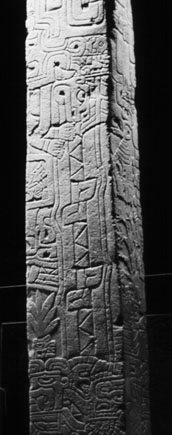Understanding Chavín and the
Origins of Andean Civilization
©2000 by James Q.
Jacobs
Chavín was once compared to the Olmecs and
depicted as the Mother Civilization of the Andes. The
term Chavín has been applied to a developmental
stage of Andean history, to an archaeological period, to
an art style and to a hypothetical empire.
Chavín has been interpreted as a culture, a
civilization and a religion.
The idea of a Chavín horizon was proposed by
Julio Tello. In the 1930s Tello claimed that
Chavín was Peru's oldest civilization. His
definition of a pan-regional Chavín culture
included attributes of ceramics, architecture and
sculpture. The incorporation of sites with some
Chavín characteristics eventually led to a
perceived culture spanning two millennia and reaching
from Ecuador to Argentina. Tello's criteria has
since been narrowed and recent research, especially
radiocarbon dating, has refined understandings of
Chavín and regional site relationships.
In the 1960s John Rowe's Andean chronology defined the
Early Horizon as the time beginning with the first
appearance of Chavín influence in Ica. This
arbitrary criteria requires a definition of
Chavín influence and a clear understanding of the
Chavín style horizon. The style can be
unevenly documented on the coast from Lambayeque to Ica,
and from Pacopampa to Ayacucho in the highlands.
Adhering to Rowe's definition presents some
problems. For one, new dates at Ica might change
the Andean chronology. And, as has been
subsequently determined, it also means that
Chavín influence precedes the first sculptures at
Chavín, the content of which defines the style,
and precedes Chavín itself.
There are several important areas to consider in
assessing the role of Chavín in the origins of
Andean civilization. Landscape context is an
important aspect of all cultural development
trajectories, and particularly so at
Chavín. In early Andean communities
dependence on more that one life zone promoted
interaction, exchange and interdependency, a pattern
first evidenced in the coastal valleys where the
exchange pattern involved the series of
elevation-stacked ecological zones beginning with
maritime resources and extending inland to agricultural
and pastoral habitats. An excellent example is
found in the Casma Valley , at Moxeke, 18 km from the ocean, where almost all animal protein was maritime.
Chavín civilization may be the best early
expression of a similar pattern on a larger ecological
scale, that of interaction between the three major
ecological zones, the coast, the highlands and the
tropical forests.

Chavín de Huantár, the archaeological
site, is uniquely situated in the region of the
Callejón de Huaylas, where there are only two
ranges in the Andes, rather than the usual three.
The glaciated Cordillera Blanca has, in a 180 km long
span, a few passes, all over 15,000 feet in
elevation. Chavín de Huantár, midway
between the coast and the jungle, is located on a route
accessing the very extensive Marañon
drainage. Almost all the large rivers of the
central Andes flow to the Amazon drainage. The
Callejón de Huaylas' Santa River drains to the
coast, transecting the Cordillera Negra. Via the
Santa Valley it is possible to cross the Andes by
crossing only one high pass.
Chronology is also significant in assessing
Chavín's presumed influence. Tello
considered Chavín to be older than the coastal
sites with Chavín style, and viewed the stylistic
evidence as indicating Chavín's expansion.
John Rowe's 1962 stylistic seriation of sculpture and of
Ica ceramics provided only a relative chronology for
Chavín. Peter Rowe's subsequent stylistic
assessment of chronological placement of coastal and
highland sites concluded that there was gradual
expansion of influence from Chavín.
In 1979 Burger clarified the ceramic sequence at the
Chavín site, naming three sequential phases based
on 11 stratigraphic excavations. Burger also
analyzed 20 carbon samples, half each from the monument
and the settlement areas. Radiocarbon measurements
established an absolute chronology for Chavín de
Huantár, spanning from 850 BC to 200 BC. By
500 BC Chavín de Huantár was a flourishing
center double in size from the time of first
construction 300 years earlier. Most of the
construction dates to 400-200 BC. Around 400 BC
the monument was remodeled and greatly expanded and the
settlement increased to over 40 ha and about 1.2 km in
length. Population may have reached 3000, making
Chavín one of the largest highland centers in the
Andes.
Radiocarbon dates from coastal sites with Chavín
style ceramics, sites that had been interpreted as
provinces of Chavín, were compared by
Burger. Three widely distributed major sites were
selected, Las Haldas, Caballo Muerto and Ancón
near Garagay. Monumental construction at Las
Haldas dates from 1190 BC to 900 BC. At Caballo
Muerto the constructions that resemble Chavín
also predate Chavín, ranging from 1730 BC to 850
BC. The presumed Chavín influenced ceramic
phases at Ancón dated from 1345 BC to 810 BC,
with a mean of 1074 BC. These coastal monumental
centers prospered between 1700 BC and 900 BC, while the
earliest constructions at Chavín dates to about
850 BC. The coastal sites are older than
Chavín. The architectural features and
iconographic style at Chavín de Huantár
actually developed elsewhere, and the direction of
influence is the reverse of what was first assumed.

Relative comparison of site size can illustrate or
define possible relationships. The Chavín
monument is less than one-tenth the size of
Sechín Alto, in the Casma Valley. The
Casma has the largest and most elaborate Initial Period
constructions. The shortest route from
Chavín to the coast, across the Cordillera Negra,
descends into the Casma Valley. Sechín Alto
covered 300-400 hectares, and it is just one of several
monument precincts in the Casma drainage.
Sechín Alto is also one of the largest
architectural complexes in the world. The monument
complex alone extends nearly 2 km. The entire
community of Chavín would easily fit in
Sechín Alto's central plazas. Also in the
Casma Valley, Las Haldas covers about five times the
area of Chavín. At Moxeke the monument
complex alone extends over a kilometer in length, with
70 platform mounds flanking the sides of the central
plaza. Other coastal monument complexes also
greatly exceed Chavín in size. Of course,
Chavín features unprecedented architecture due to
its remarkable engineering, quality masonry and very
fine sculptural stone art, in contrast to mostly earthen
and adobe plaster over stone monuments on the
coast. This may be a response to the local climate
more so than an indicator of relative importance.

Socio-political organization changes dramatically
during the Early Horizon. One expression of the
preceding Initial Period social pattern is found in the
monumental architecture. Distinct style areas of
monumental architecture are seen, with the central,
north-central and the north Peruvian coast having
distinct monument styles. Each of these zones were
represented by a major site in Burger's radiocarbon
comparisons. Early regional political
relationships may be evidenced by these style zones and
by concentrations of or by extremely large inland mounds
in the Moche, Casma and Chillón-Rimac
Valleys. Sechín Alto evidences over a
millennium of construction.

There is little evidence of economic or social
stratification during the early Initial Period in the
Casma Valley. Evidence of some stratification is
seen by the late Initial Period, with a difference in
two groups of dwellings. Dwellings attached to the
monument precinct were of more substantial
construction. New social classes may have emerged
by the end of the Initial Period, coincident with the
end of massive public architecture projects. The first
settlements to evidence social differentiation are the
Preceramic sites of Rio Seco, El Aspero and Bandurria,
communities of up to 3,000 population, a size comparable
to the maximum at Chavín.
Stratification is evidenced at Chavín in the
settlement pattern. Rich burial accompaniments in
northern highland areas during Chavín's last
phase evidences status differences, reinforcing the
status interpretation of the settlement differences at
Chavín. Craft specialization also appears
in households. The first evidence of urbanism and
these social changes date to the last phase at
Chavín only. Burger calls the site
proto-urban at this time.
Trade is an important factor in the development of
Andean civilization. Interregional trade rose
sharply during the Early Horizon. Chavín's
interaction sphere, as a supra-political entity, is
characterized by a new scale of interaction and exchange
of goods and ideas. Exchange items included
pottery, shell, stone resources, wool, textiles, metals,
and dried fish. The more unified iconography may
be related to this social change.
Chavín's location allowed flow of and/or control
of trade between major environmental zones. Long
distance trade fueled Chavín's success and
growth. Trade was dependent on llama
conveyance. Domesticated llamas first appear with
frequency at multiple sites outside their natural range
during the Early Horizon.
By 400 BC sophisticated economic systems involving
distant trading had been established and roads were
developed. The several regional spheres of
interaction during the Initial Period became a single
economic interaction sphere spanning nearly 1000 km,
from Pacopampa to Pata de Huamanga, and including
coastal, highland and the eastern Andean slopes.
Studies sourcing obsidian evidence a sharp increase in
long-distance trade. Obsidian from the Quispisisa
source, 450 km south of Chavín, reached the
northernmost extent of the Early Horizon exchange
network. Of the three phases at Chavín, the
final Janabarriu phase reflects the most extensive
communication networks, when obsidian use at
Chavín increased 500 fold. Products from
Ecuador and Chilé found their way into the
exchange network. At the same time the pattern of
interaction is uneven, indicating local determinism.
Technological innovations appear suddenly and diffuse
over a wide area during the Early Horizon. In
textiles, use of camelid hair in cotton textiles, dying
camelid hair, textile painting, resist painting,
discontinuous warps, warp wrapping, and the heddle loom
transformed the Andean textile tradition. In gold
metallurgy three dimensional forms, soldering, sweating,
welding and silver-gold alloys appear. Wide
distributions accompanied these technological
advances.
Chavín's elaborate iconography is
found on hammered gold and textiles as well as on
ceramics, stone sculpture and clay friezes.
Chavín iconography represents an unprecedented
unification of previously heterogeneous groups, yet
without total cultural homogenization. A wide
range of groups in the mid-Early Horizon modified
traditional ceramic styles, yet the pottery continues to
display regional style variations. In contrast,
textiles of the Chavín horizon do not display
regional distinctions in technology or style, and are
therefore an excellent horizon marker in areas of good
preservation.
The Early Horizon panregional ideological codification
reflects a shared ideology and a far wider group
identity than during the Initial Period.
Chavín de Huantár's iconography reflects
an ideological system incorporating material from the
tropical lowlands, the coast and the highlands.
Nonetheless, the hypothesis emerged that Chavín's
stylistic homogeneity, over a wider area than all
previous cultural styles, resulted from a single point,
rapid dispersal of the style. There was a
long-standing consensus among anthropologists and
archaeologists that Chavín style expresses a
religious ideology and represents a religious
diffusion. Rafael Larco viewed Chavín as a
pilgrimage center erected by members of a feline
cult. Rebecca Carrión called the
Chavín empire a religion that spread a
homogeneous art style. Gordon Willey interpreted
the diffusion as a peaceful spread of religious
concepts. The basis of these assumptions, rapid
dispersal from a single source, has been undermined, yet
the consensus interpreting Chavín iconography as
religious remains.
The
design features of the Chavín monumental
architecture have their origins in coastal sites.
Chavín's building style is unique and
synthesized. Chavín's Old Temple, the
initial monument, combined the architecture of the
central coast U-shaped pyramids and the north-central
coast sunken circular court, a synthesis that was seen
earlier at Sechín Alto. Some of the iconography
at Chavín is found in the clay friezes on the
earlier coastal monuments. The antecedent for low
relief stone carvings decorating the monument exterior
dates to 1200 BC at Cerro Sechín in the Casma
Valley. After 500 BC decorated cylindrical
columns, an architectural element from the northern
highlands, were added.
What was the function of Chavín? Hundreds
of decorated ceramic vessels for eating and drinking
evidence group feasting. The pottery includes
items created hundreds of kilometers from the site,
indicating possible usage by distant communities.
Coastal mussels and fish were found with the pottery,
further evidencing distant contacts. Chavín
art is basically naturalistic, lacking in political
content and devoid of historic personages or
scenes. While the consensus is for a religious
function, Karen Olsen Bruhns writes that "There is
little direct evidence concerning Chavín
religious beliefs or practices..." There is also
little direct evidence of political function.
It seems that the preeminence of Chavín de
Huantár continues to be exaggerated due to,
first, the early misidentification of Initial Period
iconographies as Chavín, second, the need to use
stone in the highlands resulting in differential
preservation, third, the sequence in the discovery and
investigations, fourth, changes in available methods,
particularly radiocarbon dating, and fifth, the
presumption of a Chavín religion.
Interaction and exchange seem adequate explanations for
the developments at Chavín in such an
economically significant location. The significant
increases in trade parallels the chronology at
Chavín, therefore I see exchange during the Early
Horizon as a very plausible explanation for the
diffusion of a universalist iconography and art style.
During the third century BC a disintegration of the
Chavín interaction sphere is evidenced by halting
of construction, replacement of Chavín style
ceramics by local styles, widespread construction of
hilltop fortresses in the highlands and coastal valleys,
a decline in interregional trade and intensified
socioeconomic stratification. Two centuries
after Chavín's fluorescence the hypothetical
civilization waned. |